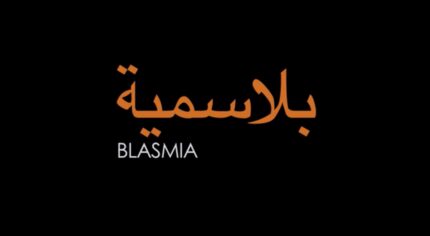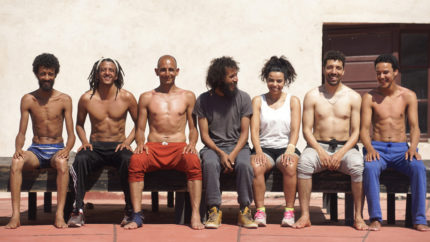
© Mariem Naciri / Daha Wassa & Arts i Love 2016
On returning from the Tangier International Conference 2016, it was not easy to deal with the many new impressions. Among a series of memories – numerous encounters and stimulating lectures – the experience of one particular performance stood out as especially moving and challenging. I was deeply touched by the avant-première of “Blasmia” (“Without a name”) staged by the young Moroccan theater company Daha-Wassa.
The announcement of the performance stated that – besides the spirit of improvisation – the group (named after an Amazigh compound word meaning “here & now”) would make use of ritualistic singing techniques, voice and body work, experimental singing, and vocal techniques. I was all the more curious because Daha-Wassa was presented as one of Morocco’s emerging companies, exemplifying its “new theater.” While it has often been underlined that Moroccan theater exists in a liminal space between East and West, fusing Western theatrical traditions and Arab-Amazigh performance cultures, I was wondering how a young performance collective would deal with this hybrid nature of theater forms and local performance traditions such as al-halqa (the circle).
It seems impossible to describe the intense physical experience that the performance of “Blasmia” produced. As a spectator, I could feel the energy circulating among the actors like never before. After this evening, however, I could sensually experience that one could hardly find a better arena than theater and performance to sense the massive changes taking place in today’s Morocco. The particularity of that specific performance seems to lie in the manner in which the performers brought their physicality to the fore. “Blasmia”, in that sense, broke with the traditional narrative tradition and presented energetic and loaded dance scenes. A variety of cultural influences, spiritual songs, and Sufi dances combined with contemporary electronic music became visible and interwoven within a network of sensual impressions through the use of modern video technology.
Placing the performer at the heart of a theatrical experimentation, I also realized that I had to learn more about the group. The following interview with Ahmed Hammoud, director of “Blasmia” and artistic director of Daha-Wassa, was conducted via email between the avant-première of “Blasmia” in September in Tangier and its première on 13 December 2016 in Rabat. With the help of Yolanda Agudo López, production director of “Blasmia”, Hammond’s French answers could be translated into English.
 Watch Teaser BLASMIA
Watch Teaser BLASMIA
How and why was Daha-Wassa founded?
Daha-Wassa was created during a free workshop in 2005 organized within the framework of our studies of dramatic art at the High Institute of Dramatic Art and Cultural Management (ISADAC) in Rabat. However, we also invited people from different backgrounds to the workshop. Saif and Dabcha, for instance, two performers in today’s performance collective, didn’t study dramatic arts in ISADAC. Following this first workshop we performed “Three nights with Madox” in 2005.
The main goal of Daha-Wassa is to pursue a daily experimental research, always in progress. The philosophy of our research is based in the “here and now”. Every action is conditioned by the circumstances of the actions’ experience (the space, the human being, the bodies, the voices… the globality of the instant/moment). The starting point is the “instant,” which we use to research where the action can be developed and deepened. We don’t have pre-established ideas, we write from the scene.
Who is part of Daha-Wassa?
The majority of Daha-Wassa members are former students of ISADAC and there are other energies, such as our performer Dabcha, who studied psychology, and he, by the way, is the most present in the performance. He has been doing a great research job on the gaze, the way of looking and being watched in performance. He focuses on a gesture and he always goes through the details. He has a firm faith in his work.
So the people that are part of the performance group Daha-Wassa are friends that I met along the way… Ten years ago. During this time, we have been working, researching, living together.
What artistic training do your performers have? How are they trained?
For this production, there were two kinds of training. On the one hand, a corporal-vocal training, and Darvish training on the other. These two types of training were part of the preparation process of the actors, not of the creative process of the performance. We did a lot of yoga, worked with voice through vocal exercises, and we started spinning without any orientation, we could call it vocal and corporal travels. In the beginning, we felt dizziness, some actors even threw up. We even noticed a psychological change… We have become slightly more stupid.
Was this a starting point for your recent performance “Blasmia”? Or is there an overall topic that you tried to address?
It was the return to the beginning, to the point itself. Once we found a point, we found a circle, and after all that, there was all the geometry.
“Blasmia” is a very energetic performance referring to many different performance styles and cultures. What have your references been?
With regard to the theme, I was very inspired by the Arab Andalusian Sunni scholar of Islam and Sufi mystic, poet, and philosopher, Ibn Arabi. I have many teachers who are my references, theater teachers as well as other life teachers. I started a spiritual process by studying the practices of so-called ‘primitive’ tribes, ancient Berber practices before the arrival of monotheism and I also deepened my knowledge of Buddhism, Taoism, Sufism—the spiritual practices that are based on the energies of nature (the elements) and in this notion of “thanking” that is repeated in all spiritual practices. For example, the notion of “recall” is repeated in all these practices, the importance of the earth and the birth, the earth is our mother. In Buddhism and Taoism there is this notion of being attentive to nature, to be attentive to the reality and to live time and the present consciously. When you’re not attentive it means you’re not fully there, and when you are not there you’re stuck with regrets of the past, or you’re in the anguish of the future. The only time you can live is now. Taoism is very similar to Sufism; it is all related to a single point, which is the Tao that has no name. It is the central point of all that exists. I was very shaken with the resemblance between Ibn Arabi and Lao Tsu.

© Daha Wassa & Arts i Love 2016
What impact or influence did the performers themselves – their biographies or bodily training – have with regard to the development of the performance “Blasmia”?
In the show, nothing is said. There are no spoken words because we already live the corporal, vocal and spiritual experience during all the residences (corporal, vocal and spiritual process for everybody, this is why almost all the actors have rotated), we only need to show ourselves naked in front of the public and say nothing. We do not speak because our bodies talk for us, our voices speak for us… Behind our bodies and voices there is a whole process. Even the food we ate focused on this spiritual choice.
Could you please talk a little about your artistic practice: How do you work?
I cooperate during the rehearsals. I always listen to and respect the proposals of the performers because they create the show. They are the raw material of the creation, it is a proposal of the performer.
The show was created via the rehearsals. Even the circular shape of the rehearsal space in Essaouira (Bastion Bab Marrakech) impacted all the rest.
I have no pre-established ideas, and I always work taking into account the proposals of the performers, and their intimate material, in a context of total complicity. For example, I asked the performers not to repeat the same thing every time and to always look for new tones, other actions that emerge during the performance.
What role does the aesthetic form play in relation to the audience to which it is shown?
Referring to the audience, I seek its participation, and create an interaction with the public, by touching them, asking the audience questions, like in the show “Blasmia”, dividing them by gender and other things in order to make them enter in the ritual. I want the audience to experience a resonance that lasts. To bring about change we must not alter the world; we must change ourselves.
Speaking of your spectators: What idea or concept do you have of your audience? What do you want them to experience?
I want to connect them with an energy of love.
That would have been a wonderful conclusion. But I still have one last question: What are your next projects?
I would like to create a Center for Theater Research at Kilometer 0 (next to Khemisset), in the plains of Middle Atlas, where the work could be developed on a daily basis, working out concrete actions of and with local people in the area, in a suitable space and environment. A center for experience-sharing with professionals from other countries, not working within the logic of the spectacle but to do research.

